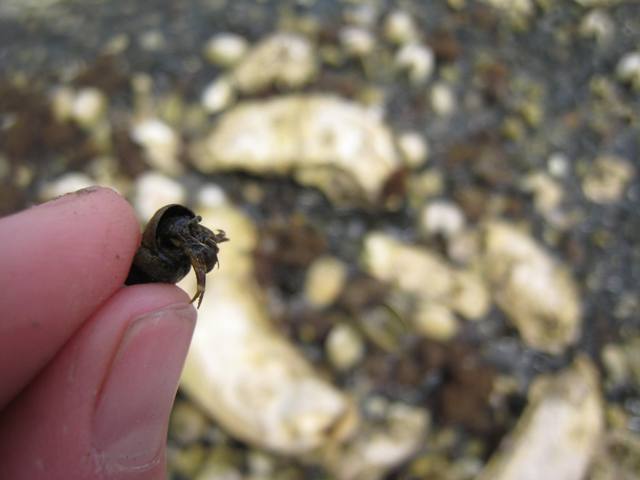Aug 8, 2011: Periwinkled hermit crabs
The other day we ran across a cast of hermit crabs living in periwinkle shells. (According to this page, "cast" is the correct term for a gathering of crabs. Now we know.) This appeared to be a pretty big cast, located relatively high on the beach, in sloughs, underneath oyster shells. It seemed pretty exclusive, too, because we didn't notice any hermits carrying around Asian mud snail shells, which are similarly sized. Just periwinkle shells.



 Periwinkles are very common on our beach (and everywhere else). They mainly eat algae and lichens, using their radula to scrape their food free of whatever rock or shell it's attached to. They can't tolerate constant submersion, which explains why we always find them at the waterline in our oyster live tank. There are several species of periwinkle in Puget Sound, but to tell them apart you have to inspect their reproductive organs, and we've never gone there. The periwinkled hermits in the photo above are hanging out on an oyster that's been invaded by boring sponge. There are many sponge species in Puget Sound, and several sound like they were either discovered by an English speaking cousin of the guy who named the Grand Tetons, or by a 4 month old infant: breast sponge, nipple sponge, retractable nipple sponge, you get the idea. Boring sponge, a name that actually makes sense, comes from the sponge's ability to bore through shell, producing the holes you see in the oyster above... it's only lame if you're an oyster farmer trying to grow good-looking mollusks. Boring sponges are filter feeders, not oyster eaters, but if they grow too extensive they can kill their molluscan hosts. They perform the very valuable ecological function of converting shells back into sediment. We've done several posts about hermits in the past, including one where we found a naked cast of hermit crabs wiggling around without any shells. Read them here and here.
Periwinkles are very common on our beach (and everywhere else). They mainly eat algae and lichens, using their radula to scrape their food free of whatever rock or shell it's attached to. They can't tolerate constant submersion, which explains why we always find them at the waterline in our oyster live tank. There are several species of periwinkle in Puget Sound, but to tell them apart you have to inspect their reproductive organs, and we've never gone there. The periwinkled hermits in the photo above are hanging out on an oyster that's been invaded by boring sponge. There are many sponge species in Puget Sound, and several sound like they were either discovered by an English speaking cousin of the guy who named the Grand Tetons, or by a 4 month old infant: breast sponge, nipple sponge, retractable nipple sponge, you get the idea. Boring sponge, a name that actually makes sense, comes from the sponge's ability to bore through shell, producing the holes you see in the oyster above... it's only lame if you're an oyster farmer trying to grow good-looking mollusks. Boring sponges are filter feeders, not oyster eaters, but if they grow too extensive they can kill their molluscan hosts. They perform the very valuable ecological function of converting shells back into sediment. We've done several posts about hermits in the past, including one where we found a naked cast of hermit crabs wiggling around without any shells. Read them here and here.
